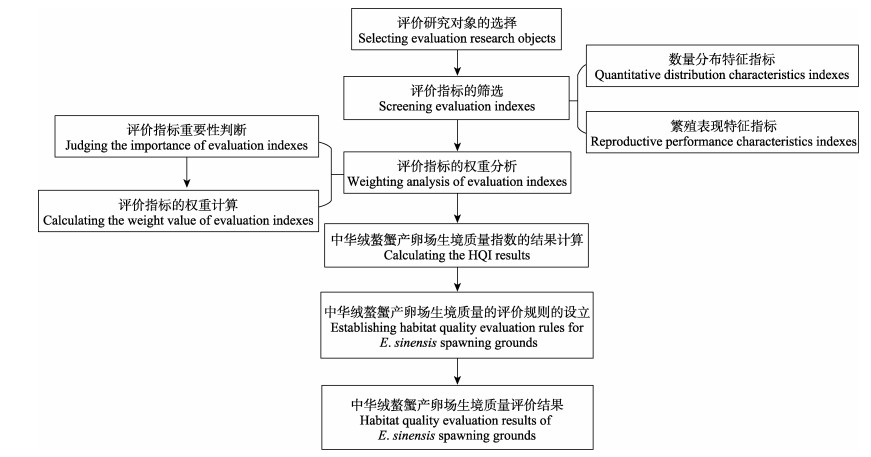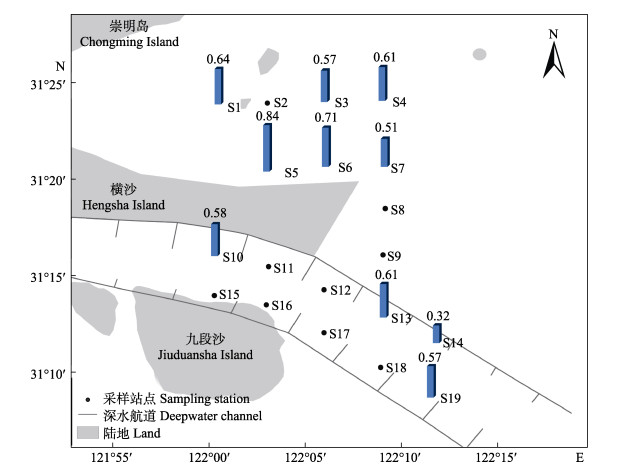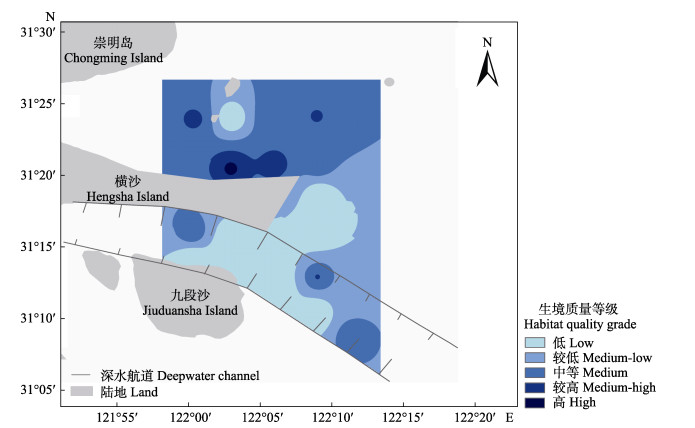2. 南京农业大学无锡渔业学院 江苏 无锡 214081;
3. 上海长江口渔业资源增殖和生态修复工程技术研究中心 上海 200090
2. Wuxi Fisheries College, Nanjing Agricultuaral University, Wuxi 214081, China;
3. Shanghai Engineering Research Center of Fisheries Resources Enhancement and Ecological Restoration of the Yangtze Estuary, Shanghai 200090, China
中华绒螯蟹(Eriocheir sinensis)是长江流域渔业资源的重要组成物种之一,因其具有生殖洄游的特殊习性,中华绒螯蟹会在每年的秋冬之际洄游至长江口水域进行繁殖产卵活动(陈立侨等, 2017)。中华绒螯蟹的生殖洄游所形成的蟹汛景象曾是长江口水域著名的“五大鱼汛”之一(庄平, 2012)。然而,在20世纪80年代中后期,由于上游水利工程建设(陈吉余等, 1995)、河口沿岸土地围垦(Xue et al, 2016)以及污染输入(张列士等, 1988)等因素,中华绒螯蟹的河口产卵生境遭受着生境变迁、水环境质量下降等恶劣影响,加之人们对中华绒螯蟹资源的过度捕捞利用,导致中华绒螯蟹资源量急剧锐减(徐东坡等, 2015; 谷孝鸿等, 2001)。近年来,为制定科学合理的中华绒螯蟹资源保护策略,中华绒螯蟹的河口产卵生境受到了人们的重点关注。长江口水域是中华绒螯蟹生活史关键阶段的重要栖息生境。目前,国内相关学者主要以中华绒螯蟹抱卵蟹作为其产卵生境的监测研究对象,从资源量分布的角度探究了长江口中华绒螯蟹产卵场的分布格局及生境特征状况(蒋金鹏等, 2014; 耿智, 2018),为制定中华绒螯蟹禁捕期和保护区的规划等管理策略提供了初步参考。
开展渔业生境的监测、评价及管理研究对保障渔业资源的可持续发展具有重要意义(张立斌等, 2012; 卞晓东等, 2018; 金显仕等, 2015)。其中,生境质量评价研究作为有效了解水域生境功能的重要手段(Dobson et al, 2006; Gibson et al, 1994),能够为进一步完善渔业物种生境管理策略提供更为全面的理论支撑。目前,针对河口水域渔业物种生境质量评价的研究主要集中于鱼类物种,如根据反映幼鱼生长发育的特征指标(如RNA/DNA比值、耳石边缘增量宽度和Fulton´s K条件指数等)进行育幼场生境质量评价研究(Amara et al, 2009; Yamashita et al, 2003),或根据反映成鱼繁殖性能的特征指标(如性腺指数和肝胰腺指数等)进行产卵场生境质量评价研究(Lloret et al, 2003; Vitale et al, 2008)。长江口水域作为长江流域唯一、全国最大的中华绒螯蟹产卵场,其生境质量状况对中华绒螯蟹资源量具有重大影响。因此,本研究从反映产卵场生境质量的中华绒螯蟹繁殖产卵行为特征出发,侧重于繁殖表现特征并结合数量分布特征作为中华绒螯蟹产卵场生境质量评价研究的依据。通过对评价指标的筛选和权重分析以及评价规则的确立等步骤,构建中华绒螯蟹产卵场生境质量指数,为探究长江口中华绒螯蟹产卵场生境质量状况提供科学工具,以期为中华绒螯蟹资源恢复和河口生境管理提供科学依据。
1 材料与方法 1.1 研究区域及数据采集根据耿智(2018)针对长江口中华绒螯蟹产卵活动时间及产卵场分布的监测研究结果,于2020年12月26—28日在长江口水域针对中华绒螯蟹抱卵蟹(以下简称抱卵蟹)进行调查采集,采样调查站点具体如图 1所示(科研渔业特许捕捞)。每个采样点通过放置2条刺网(高1.6 m、长100 m、网目10 cm)进行样本采集,于落潮时放置,涨潮时收网。在各站点调查采样的过程中,对影响中华绒螯蟹繁殖产卵活动的关键生境因子进行采集测量,主要包括水深(DEP)、浊度(NTU)、底层水的溶氧(DO)、盐度(SAL)和温度(T)。

|
图 1 长江口中华绒螯蟹产卵场调查站点 Fig.1 E. sinensis spawning grounds survey sites in the Yangtze River estuary |
将采集的抱卵蟹(共107只)带回实验室进行分析,统计每个站点获取的抱卵蟹数量,并采用单位捕捞努力量渔获量(catch per unit effort, CPUE)分析抱卵蟹的数量分布特征,CPUE为刺网每小时每网捕捞的抱卵蟹数量,单位为ind./(net·h)。然后,对每只抱卵蟹样本进行测量、解剖和称重等步骤获取壳宽、去卵后体重、肝胰腺重和受精卵团重数据。其中,长度数据精确到0.01 mm,重量数据精确到0.01 g。繁殖力的测量方法参考Pinheiro等(2000)的步骤,将受精卵团先用无水乙醇浸泡12 h,然后在60 ℃烘箱烘干至恒重,根据3个计数子样本的干重和受精卵团的总干重计算总受精卵团的数量,即绝对繁殖力。参照吴旭干等(2007)的方法计算抱卵蟹的相对繁殖力(relative fecundity, RF)、肝胰腺指数(hepatosomatic index, HSI)、生殖指数(reproductive effort, RE)和肥满度(condition factor, CF),计算公式如下:
| $ \begin{gathered} {\text{RF (eggs/g)=AF/BW}}\\ \mathrm{HSI}(\%)=\mathrm{HW} / \mathrm{BW} \times 100 \% \\ \mathrm{RE}(\%)=\mathrm{FW} / \mathrm{BW} \times 100 \% \\ \mathrm{CF}=\mathrm{BW} / \mathrm{CW}^3 \times 100 \end{gathered} $ |
式中,AF为抱卵蟹的绝对繁殖力(eggs),BW为抱卵蟹的去卵体重(g),HW为抱卵蟹的肝胰腺重量(g),FW为抱卵蟹的受精卵团重(g),CW为抱卵蟹的甲壳宽度(mm)。
1.2 中华绒螯蟹产卵场生境质量指数的构建从中华绒螯蟹繁殖产卵活动出发,以抱卵蟹为中华绒螯蟹产卵场生境质量评价研究对象,通过评价指标的筛选和权重分析以及评价规则等步骤完成中华绒螯蟹产卵场生境质量指数(HQI)的构建(图 2)。

|
图 2 中华绒螯蟹产卵场生境质量指数构建的示意图 Fig.2 Schematic diagram of construction of habitat quality index of E. sinensis spawning grounds |
以抱卵蟹的数量分布特征(即CPUE)和繁殖表现特征(即AF、RF、HSI、RE和CF)作为长江口中华绒螯蟹产卵场生境质量评价候选指标。为避免选取繁殖表现特征指标受中华绒螯蟹自身规格的影响,将壳宽与评价指标进行相关系数检验,去除受规格影响以及存在内在联系的评价指标。
1.2.2 评价指标的权重分析根据评价指标的特点建立层次评价体系,即目标层为中华绒螯蟹产卵场生境质量评价;第一准则层为数量分布特征,第二准则层为繁殖表现特征;指标层为基于相关分析筛选后的评价指标(CPUE、AF、RF、HSI、RE和CF)。首先,将影响中华绒螯蟹繁殖产卵活动的环境因子(DEP、NTU、DO、SAL和T)分别与准则层和指标层进行冗余分析(redundancy analysis, RDA),根据冗余分析的结果了解评价指标受环境特征的影响程度,并以此作为确定评价指标权重的分析依据。通过层次分析法确定评价指标权重值,结合1~9标度法(Saaty, 1990) (表 1),分别针对准则层、指标层进行判断矩阵的构造以及权重值的计算。
|
|
表 1 比较标度及其定义 Tab.1 Comparison scale and its definition |
本研究中,选取的评价指标均为正向指标,即指标数值越大,反映生境质量状况越高。结合评价指标的筛选分析及权重确定的结果,通过多指标综合评分法(林雄等, 2019)计算各站点中华绒螯蟹产卵场生境质量指数。多指标综合评分法计算公式的示例如下:
| $ {M_i} = {W_A} \times \frac{{{A_i}}}{{{A_{{\text{max}}}}}} + {W_B} \times \frac{{{B_i}}}{{{B_{{\text{max}}}}}} + {W_C} \times \frac{{{C_i}}}{{{C_{{\text{max}}}}}} + {W_D} \times \frac{{{D_i}}}{{{D_{{\text{max}}}}}} $ |
式中,Mi为i站点的中华绒螯蟹产卵场生境质量指数,A、B、C和D为相关分析筛选后选用的评价指标。WA、WB、WC和WD分别代表各评价指标的权重值。Ai、Bi、Ci和Di分别为i站点各评价指标的实测值。Amax、Bmax、Cmax和Dmax分别为基于所有采样站点中获取的各评价指标的最大值。
1.2.4 评价规则的确立多指标综合评分法的应用将中华绒螯蟹产卵场生境质量指数的计算结果限制在0~1之间。若数值越接近0,表示生境质量水平越低;数值越接近1,表示生境质量水平越高。根据各站点生境质量指数的计算结果对中华绒螯蟹产卵场生境质量等级进行分类,并制定中华绒螯蟹产卵场生境质量评价规则(表 2)。
|
|
表 2 中华绒螯蟹产卵场生境质量评价规则 Tab.2 Habitat quality evaluation rules of E. sinensis spawning grounds |
以1.2过程计算的中华绒螯蟹产卵场生境质量指数为响应变量,各环境因子为解释变量,通过冗余分析的单独效应(simple effect)明确影响中华绒螯蟹产卵场生境质量的关键环境因子。
1.4 数据分析使用SPSS 25.0的Sperman相关分析工具检验评价指标之间的相关性,冗余分析通过Canoco 5.0进行。基于设立的中华绒螯蟹产卵场生境质量评价规则,应用ArcGIS 10.4的空间分析模块,通过反距离权重插值法模拟长江口中华绒螯蟹产卵场生境质量的分布趋势。
2 结果与分析 2.1 评价指标的筛选结果繁殖表现特征中各评价指标的相关系数检验如表 3所示。其中,绝对繁殖力、肥满度与壳宽的相关关系显著(P<0.01),表明受抱卵蟹自身规格影响较大。生殖指数与绝对繁殖力、相对繁殖力的相关关系显著(P<0.01)。评价指标中仅发现相对繁殖力与肝胰腺指数之间无显著相关关系。因此,选取肝胰腺指数和相对繁殖力作为中华绒螯蟹产卵场生境质量评价中繁殖表现特征指标。
|
|
表 3 繁殖表现特征各评价指标的Sperman相关检验系数 Tab.3 Sperman correlation test coefficient of each evaluation index of reproductive performance characteristics |
各评价指标与环境因子的冗余分析结果如表 4所示。在中华绒螯蟹产卵场生境质量评价体系的准则层中,环境因子对繁殖表现特征的解释率达到91.9% (F=9.0, P=0.042),高于其数量分布特征,表明环境特征对抱卵蟹的繁殖表现特征的影响程度更大。在指标层中,环境因子对相对繁殖力解释率最大,为92.2% (F=9.5, P=0.036),表明抱卵蟹的相对繁殖力特征指标受环境特征影响最大,与生境特征之间具有良好的响应关系。根据评价指标与环境因子之间的冗余分析结果,对评价指标的重要性进行判断,以便于后续应用层次分析法进行权重值的计算,即繁殖表现特征>数量分布特征,相对繁殖力>肝胰腺指数。
|
|
表 4 评价指标与环境因子的冗余分析结果 Tab.4 Redundancy analysis results of evaluation indexes and environmental factors |
结合层次评价体系的特点,分别对准则层和指标层进行两两比较。根据冗余分析的结果,采用标度“5”构造判断矩阵,进行权重值的计算。即繁殖表现特征比数量分布特征稍重要,相对繁殖力比肝胰腺指数稍重要。单位捕捞努力量渔获量、相对繁殖力和肝胰腺指数的权重值分别为0.17、0.69和0.14。
2.3 中华绒螯蟹产卵场生境质量的分布状况通过多指标综合评分法计算各站点的中华绒螯蟹产卵场生境质量指数,具体如图 3所示。基于19个调查站点的研究结果显示,共计10个站点采集到中华绒螯蟹抱卵蟹,主要分布在横沙北岸水域。各站点的中华绒螯蟹产卵场生境质量指数介于0.33~0.84之间。其中,生境质量等级在中等及以上的共计9个调查站点,占47%。根据设立的中华绒螯蟹产卵场生境质量评价规则,长江口中华绒螯蟹产卵场生境质量的分布趋势见图 4。总体上,横沙北岸自然水域的中华绒螯蟹产卵场生境质量水平高于深水航道水域。

|
图 3 长江口各站点的中华绒螯蟹产卵场生境质量指数 Fig.3 The habitat quality index of E. sinensis spawning grounds at various stations in the Yangtze River estuary 柱状图上的数字为中华绒螯蟹产卵场生境质量指数。 The number on the histogram is the habitat quality index of E. sinensis spawning grounds. |

|
图 4 长江口中华绒螯蟹产卵场生境质量分布趋势 Fig.4 Habitat quality distribution trend of E. sinensis spawning grounds in Yangtze River estuary |
环境因子与数量分布特征指标、中华绒螯蟹产卵场生境质量指数的冗余分析比较结果如表 5所示。相较于数量分布特征指标(CPUE, 72.2%),环境因子对本研究所构建的中华绒螯蟹产卵场生境质量指数(HQI, 93.7%)的解释率更高。每个环境因子单独作为解释变量时,对中华绒螯蟹产卵场生境质量指数的解释率如表 6所示。其中,底层水的DO、SAL和T对中华绒螯蟹产卵场生境质量指数的解释率最高,分别为74.0% (F=22.7, P=0.004)、44.0% (F=6.3, P=0.044)、33.0% (F=3.9, P=0.076),表明底层水的DO、SAL和T是影响中华绒螯蟹产卵场生境质量的关键环境因子。
|
|
表 5 CPUE和HQI对中华绒螯蟹产卵场生境质量解释差异比较 Tab.5 Comparison of CPUE and HQI for explaining differences in habitat quality of E. sinensis spawning grounds |
|
|
表 6 影响中华绒螯蟹产卵场生境质量的关键环境因子分析 Tab.6 Analysis of key environmental factors affecting the habitat quality of E. sinensis spawning grounds |
生理特征指标能够综合反映渔业物种在特定生活史阶段的生存需求以及对河口水域生境功能的利用,广泛应用于评价河口水域渔业物种不同类型的生境质量状况。目前,针对河口水域渔业物种生境质量评价研究主要集中在鱼类物种。由于鱼类在生活史各阶段的能量分配策略不同,导致其在不同生活史阶段呈现不同的生存表现特征。幼鱼阶段鱼类将获取的能量几乎全部用于体细胞的生长,以获得良好的生长发育条件(Biro et al, 2005; Post et al, 2001)。而在鱼类的繁殖期,鱼类会将获取的能量以脂肪的形式储存在肝脏中,为性腺组织的发育和繁殖产卵活动提供营养物质和能量储备(Do Carmo et al, 2019; Grande et al, 2016)。鱼类的能量分配策略反映了不同生活史阶段的生存需求和生境需求。因此,RNA/DNA比值、耳石边缘增量宽度和Fulton´s K条件指数等反映幼鱼生长发育的生理特征指标常用于区分育幼场生境质量差异,性腺指数和肝胰腺指数等反映成鱼繁殖性能的生理特征指标常用于评价产卵场生境质量状况。在许多河口水域鱼类生境质量的评价研究中,也进一步强调了生理特征指标在生境质量评价研究中的重要性。许多研究明确指出,生理特征指标在应对生境特征变化(de Raedemaecker et al, 2012)、水域污染状况(Meng et al, 2001)和环境压力水平(Amara et al, 2009)等方面具有良好的响应,是指示生境质量状况的高敏感性指标。
蟹类在繁殖期的能量分配策略与鱼类相似(Bo et al, 2021; 喻杰等, 2016),但二者具有显著不同的繁殖生物学特征。蟹类在完成产卵活动后,会将受精卵团固着于腹肢进行抱卵孵化。因此,雌蟹的抱卵状态为判断其产卵场的分布格局提供了有力的证据(Ogburn et al, 2015)。本研究充分考虑中华绒螯蟹特殊的繁殖生物学特征,以抱卵蟹为研究对象,选取绝对繁殖力、相对繁殖力和生殖指数等繁殖特征指标作为其产卵场生境质量评价研究的候选指标。经过相关分析检验,最终以相对繁殖力和肝胰腺指数作为中华绒螯蟹产卵场生境质量评价研究的繁殖特征指标。其中,相对繁殖力作为蟹类物种产卵能力的体现,广泛用于评估蟹类的繁殖性能(吴旭干等, 2007)。肝胰腺作为甲壳类动物重要的能量储存组织,具有吸收和储存营养物质的功能,能够为中华绒螯蟹繁殖产卵活动和性腺组织发育提供能量来源和营养物质基础(封强梅等, 2020; 成永旭等, 1998)。因此,通过肝胰腺指数能够了解中华绒螯蟹繁殖产卵阶段的能量储备状况。
本研究结果表明,结合繁殖表现特征指标所构建的中华绒螯蟹产卵场生境质量指数较单一的数量分布特征指标,具有量化评估生境质量的明显优势(表 5)。因此,从中华绒螯蟹繁殖产卵行为特征出发,将繁殖表现特征指标应用于中华绒螯蟹产卵场生境质量指数构建中具有重要意义。
3.2 权重分析在中华绒螯蟹产卵场生境质量指数构建中的必要性在应用多种指标进行综合评价的过程中,评价指标权重的确定直接影响到评价结果的准确性。层次分析法在处理评价指标权重中具有应用灵活、分析全面等优势,广泛应用于生态健康评估和环境适宜性评价等诸多领域(喻良等, 2002; 杨丽娜, 2011; 崔康成等, 2019)。但传统的层次分析法在分析权重的过程中过于依赖人为主观的判断(刘洋等, 2002),难以准确体现被赋值因子的相对重要性,无法对评价指标权重值进行客观解释。由于中华绒螯蟹繁殖产卵活动主要受河口水域的环境特征影响(蒋金鹏, 2014)。在本研究中,通过统计分析计算环境特征对各评价指标的影响程度,并以此作为评价指标权重分析的主要依据。特征变量的重要性结果表明,繁殖表现特征(91.09%)>数量分布特征(72.2%);在繁殖表现特征中,相对繁殖力(92.2%)>肝胰腺指数(65.6%)。因此,在构建HQI的过程中,根据特征变量的相对重要性,对RF、HSI和CPUE进行了由大到小的权重赋值。本研究通过客观的统计分析完成了评价指标重要程度的定性分析,弥补了层次分析法应用过程中缺乏统计量化依据的缺点。
3.3 长江口中华绒螯蟹产卵场生境质量评价研究结果蒋金鹏等(2014)根据2013年4—5月的长江口中华绒螯蟹抱卵蟹资源量的捕捞结果,应用栖息地适宜性指数分析了抱卵蟹在长江口水域的适宜栖息生境分布,其研究结果表明,抱卵蟹适宜栖息在横沙以东以及九段沙东侧水域。但由于其采样调查的时间主要在中华绒螯蟹抱卵阶段进行,所以其研究结果很难为本研究提供较多参考。在本研究中,聚焦于中华绒螯蟹的产卵期进行调查,通过构建HQI工具分析了长江口中华绒螯蟹产卵场生境质量分布状况,评价研究结果发现,横沙北岸水域中华绒螯蟹产卵场生境质量水平高于深水航道水域。这可能由于深水航道工程建设直接改变了中华绒螯蟹产卵场的原有生境特征,导致中华绒螯蟹重新选择适宜的水域生境进行繁殖产卵活动。范中亚等(2012)研究发现,深水航道工程建设直接导致航道水域的盐度分布线下移。叶属峰等(2004)的研究也同样发现,深水航道工程建设直接导致局部水域生态结构发生改变,对中华绒螯蟹产卵造成了生境破碎化的恶劣影响。此外,吴晓峰(2020)在2017—2018年12月下旬对长江口中华绒螯蟹资源调查研究结果也同样表明,横沙北岸水域采集的抱卵蟹相对繁殖力水平要高于长江口其他水域。因此,横沙北岸水域可能是长江口中华绒螯蟹产卵场高质量区域。
生理特征指标的应用为探究长江口中华绒螯蟹产卵场生境质量分布状况提供了有效依据,针对中华绒绒螯蟹产卵场生境质量评价研究结果,在开展长江口中华绒螯蟹产卵场生境管理策略中,应进一步加强对横沙北岸水域的保护,如通过设立禁捕期和保护区等手段。另一方面,未来可开展针对深水航道水域相应的生境修复研究工作。
3.4 中华绒螯蟹产卵场生境质量指数的应用价值目前,已经开展了关于中华绒螯蟹产卵场适宜生境评价的相关研究,主要是通过抱卵蟹的数量分布特征指标(丰度)与环境因子之间构建联系,以探究中华绒螯蟹产卵场的适宜生境分布格局及生境特征。如蒋金鹏等(2014)通过构建栖息地适宜性指数模型(habitat suitability index, HSI)分析了抱卵蟹的丰度指标与环境因子之间的关系,以探究长江口抱卵蟹适宜分布的环境特征状况,即盐度9~15、流速1.3~1.5 m/s、水深3~6 m、透明度10~23 cm的长江口水域。耿智(2018)则通过广义相加模型(generalized additive model, GAM)研究了抱卵蟹的数量分布特征与关键环境因子之间的关系,其研究结果表明,抱卵蟹适宜栖息在底层盐度为5~15、表层流速为0.6~1.2 m/s、透明度<16 cm、底层溶氧>6.4 mg/L的长江口水域。数量分布特征指标是了解渔业物种适宜生境分布格局及生境特征的基础(马稳等, 2022; 周磊等, 2021),但仅通过数量分布特征与环境因子之间的统计学关系,无法进一步深入解释造成渔业物种分布差异的原因与机制。
本研究立足于中华绒螯蟹繁殖产卵活动,侧重于中华绒螯蟹产卵行为的繁殖表现特征,并结合数量分布特征,作为中华绒螯蟹产卵场生境质量评价依据。根据评价指标的特点,通过评价指标的筛选、评价指标权重分析、评价方法的确立等步骤构建了中华绒螯蟹产卵场生境质量指数,为探究中华绒螯蟹产卵场生境质量状况提供了更为有效的量化工具。中华绒螯蟹产卵场生境质量指数与环境因子的分析结果表明,溶氧、盐度和水温是影响中华绒螯蟹产卵场生境质量的关键因素。在蓝蟹(Callinectes sapidus)、疣酉妇蟹(Eriphia verrucosa)和中华鲎(Tachypleus tridentatus)等甲壳类物种中也同样发现,溶氧、盐度和水温是影响其产卵生境选择的重要环境驱动因子(Anderson et al, 2017; Erkan et al, 2008; Mohamad et al, 2019)。
针对中华绒螯蟹河口生活史的产卵阶段,通过分析构建HQI所筛选的繁殖表现特征指标(RF、HSI)和影响中华绒螯蟹产卵行为关键环境因子的相对重要性结果(溶氧>盐度>水温,表 6),为解释中华绒螯蟹产卵分布的生理机制提供了依据。充足的溶氧是水生生物进行各项生命活动的必要条件。李进(2009)研究发现,红螯螯虾(Cherax quadricarinatus)的溶氧需达到一定水平(5mg/L),其性腺才能发育成熟,亲体才能完成产卵活动。基于蟹类特殊的繁殖生物学特征,Baeza等(2002)和Fernández等(2002)研究均发现,雌蟹在抱卵期间的“育雏”行为为胚胎发育在溶氧供应方面发挥着关键作用,随着胚胎发育过程中对溶氧的需求逐渐增加,雌蟹腹肢的搅动频率也逐渐增加,而这一过程也导致了雌蟹自身耗氧量的增加。因此,从蟹类特殊的繁殖习性角度出发,溶氧可能是影响中华绒螯蟹产卵阶段的关键环境因子。盐度对中华绒螯蟹的影响主要体现在性腺发育、交配和产卵等环节。吴旭干等(2013)研究表明,低盐度海水(盐度为15)刺激能促进中华绒螯蟹的性腺发育以及交配活动。对于长江口水域而言,受长江径流影响,河口水域的盐度条件呈梯度变化(叶君等, 2019)。因此,河口水域盐度的差异分布可能会导致中华绒螯蟹的繁殖性能呈现差异表现。温度主要影响中华绒螯蟹受精卵的胚胎发育状况。王吉桥等(2005)研究发现,中华绒螯蟹受精卵发育的生物学零度为7.7 ℃。赵云龙等(1993)研究发现,在适宜水温范围内(9.6~26 ℃),温度越高,受精卵的胚胎发育越快,孵化周期越短。因此,相较于溶氧和盐度,温度对中华绒螯蟹产卵行为的影响可能较弱。
综上所述,本研究从中华绒螯蟹繁殖产卵活动的角度出发,将抱卵蟹的繁殖表现特征与数量分布特征作为中华绒螯蟹产卵场生境质量评价研究依据,根据评价指标的特点构建了中华绒螯蟹产卵场生境质量指数,从生境功能的角度探究了长江口中华绒螯蟹产卵场生境质量分布状况,并进一步揭示中华绒螯蟹进行繁殖产卵活动对关键生境因子的需求。
AMARA R, SELLESLAGH J, BILLON G, et al. Growth and condition of 0-group European flounder, Platichthys flesus as indicator of estuarine habitat quality. Hydrobiologia, 2009, 627(1): 87-98 DOI:10.1007/s10750-009-9717-9 |
ANDERSON J, OLSEN Z, GLEN SUTTON T W, et al. Environmental drivers of the spatial and temporal distribution of spawning blue crabs Callinectes sapidus in the western Gulf of Mexico. North American Journal of Fisheries Management, 2017, 37(4): 920-934 DOI:10.1080/02755947.2017.1335255 |
BAEZA J A, FERNÁNDEZ M. Active brood care in Cancer setosus (Crustacea: Decapoda): The relationship between female behaviour, embryo oxygen consumption and the cost of brooding. Functional Ecology, 2002, 16(2): 241-251 DOI:10.1046/j.1365-2435.2002.00616.x |
BIAN X D, WAN R J, JIN X S, et al. Ichthyoplankton succession and assemblage structure in the Bohai Sea during the past 30 years since the 1980s. Progress in Fishery Sciences, 2018, 39(2): 1-15 [卞晓东, 万瑞景, 金显仕, 等. 近30年渤海鱼类种群早期补充群体群聚特性和结构更替. 渔业科学进展, 2018, 39(2): 1-15] |
BIRO P A, POST J R, ABRAHAMS M V. Ontogeny of energy allocation reveals selective pressure promoting risk-taking behavior in young fish cohorts. Proceedings of the Royal Society B: Biological Sciences, 2005, 272(1571): 1443-1448 DOI:10.1098/rspb.2005.3096 |
BO Q K, LU Y Z, MA C, et al. Reproductive biology and biochemical changes in female mantis shrimp Oratosquilla oratoria (Stomatopoda) with ovary development from the Tianjin coastal zone of Bohai Bay. Aquaculture, 2021, 534: 736239 DOI:10.1016/j.aquaculture.2020.736239 |
CHEN J Y, XU H G. Impacts of the Yangtze River Three-Gorge hydro-engineering works on the Yangtze estuary. Resources and Environment in the Yangtze Valley, 1995, 4(3): 242-246 [陈吉余, 徐海根. 三峡工程对长江河口的影响. 长江流域资源与环境, 1995, 4(3): 242-246] |
CHEN L Q, DU N S. Biology of Eriocheir sinensis. Beijing: Science Press, 2017: 158-160 [陈立侨, 堵南山. 中华绒螯蟹生物学. 北京: 科学出版社, 2017: 158-160]
|
CHENG Y X, DU N S, LAI W. Lipid composition in hepatopancreas of Chinese mitten crab Eriocheir sinensis at different stages. Acta Zoologica Sinica, 1998, 44(4): 420-429 [成永旭, 堵南山, 赖伟. 不同阶段中华绒螯蟹肝胰腺的脂类及脂肪酸组成. 动物学报, 1998, 44(4): 420-429] |
CUI K C, LIU W, GAO W Y, et al. Suitability index construction and weight analysis for the spawning ground of Oncorhynchus keta. Chinese Journal of Ecology, 2019, 38(12): 3762-3770 [崔康成, 刘伟, 高文燕, 等. 大麻哈鱼产卵场适宜性指数构建及权重分析. 生态学杂志, 2019, 38(12): 3762-3770] |
DE RAEDEMAECKER F, BROPHY D, O'CONNOR I, et al. Dependence of RNA: DNA ratios and Fulton's K condition indices on environmental characteristics of plaice and dab nursery grounds. Estuarine, Coastal and Shelf Science, 2012, 98: 60-70 DOI:10.1016/j.ecss.2011.11.033 |
DO CARMO J P, DA Costa M R, ARAÚJO F G. Energy acquisition and allocation to the gonadal development of Cynoscion leiachus (Perciformes, Sciaenidae) in a tropical Brazilian bay. Marine Biology Research, 2019, 15(2): 170-180 DOI:10.1080/17451000.2019.1610777 |
DOBSON A, LODGE D, ALDER J, et al. Habitat loss, trophic collapse, and the decline of ecosystem services. Ecology, 2006, 87(8): 1915-1924 DOI:10.1890/0012-9658(2006)87[1915:HLTCAT]2.0.CO;2 |
ERKAN M, BALKIS H, KURUN A, et al. Seasonal variations in the ovary and testis of Eriphia verrucosa (Forskal, 1775) (Crustacea: Decapoda) from Karaburun, SW Black Sea (SC). Pakistan Journal of Zoology, 2008, 40(3): 217-221 |
FAN Z Y, GE J Z, DING P X, et al. Effect of the deep waterway project on the salinities in the north passage of the Changjiang Estuary. Journal of East China Normal University (Natural Science), 2012(4): 181-189 [范中亚, 葛建忠, 丁平兴, 等. 长江口深水航道工程对北槽盐度分布的影响. 华东师范大学学报: 自然科学版, 2012(4): 181-189] |
FENG Q M, LONG X W, JIANG X D, et al. Changes of tissue indices and lipid composition of wild adult Chinese mitten crab (Eriocheir sinensis) during catadromous migration. Journal of Shanghai Ocean University, 2020, 29(2): 234-241 [封强梅, 龙晓文, 姜晓东, 等. 长江野生中华绒螯蟹降海洄游过程中组织系数和脂类组成的变化. 上海海洋大学学报, 2020, 29(2): 234-241] |
FERNÁNDEZ M, PARDO L M, BAEZA J A. Patterns of oxygen supply in embryo masses of brachyuran crabs throughout development: The effect of oxygen availability and chemical cues in determining female brooding behavior. Marine Ecology Progress Series, 2002, 245: 181-190 DOI:10.3354/meps245181 |
GENG Z. The environment adaptability and conservation strategy of Eriocheir sinensis in estuarine life stages. Doctoral Dissertation of East China Normal University, 2018, 69–75 [耿智. 中华绒螯蟹河口生活史阶段的环境适应性及保护策略. 华东师范大学博士研究生学位论文, 2018, 69–75]
|
GIBSON R N. Impact of habitat quality and quantity on the recruitment of juvenile flatfishes. Netherlands Journal of Sea Research, 1994, 32(2): 191-206 DOI:10.1016/0077-7579(94)90040-X |
GRANDE M, MURUA H, ZUDAIRE I, et al. Energy allocation strategy of skipjack tuna Katsuwonus pelamis during their reproductive cycle. Journal of Fish Biology, 2016, 89(5): 2434-2448 DOI:10.1111/jfb.13125 |
GU X H, ZHAO F S. Resources and culturing situation of Chinese mitten crab (Eriocheir sinensis) and species character conservation. Journal of Lake Sciences, 2001, 13(3): 267-271 [谷孝鸿, 赵福顺. 长江中华绒螯蟹的资源与养殖现状及其种质保护. 湖泊科学, 2001, 13(3): 267-271] |
JIANG J P, FENG G P, ZHANG L Z, et al. Preliminary assessment on habitat suitability of Eriocheir sinensis spawning crabs in Yangtze River estuary. Marine Fisheries, 2014, 36(3): 232-238 [蒋金鹏, 冯广朋, 章龙珍, 等. 长江口中华绒螯蟹抱卵蟹生境适宜度初步评估. 海洋渔业, 2014, 36(3): 232-238] |
JIANG J P. The distribution features of the spawning ground of Eriocheir sinensis and correlation to major environmental factors in Yangtz River estuary. Master′s Thesis of Shanghai Ocean University, 2014 [蒋金鹏. 长江口中华绒螯蟹产卵场分布及与重要环境因子的相关性. 上海海洋大学硕士研究生学位论文, 2014]
|
JIN X S, DOU S Z, SHAN X J, et al. Hot spots of frontiers in the research of sustainable yield of Chinese inshore fishery. Progress in Fishery Sciences, 2015, 39(2): 124-131 [金显仕, 窦硕增, 单秀娟, 等. 我国近海渔业资源可持续产出基础研究的热点问题. 渔业科学进展, 2015, 39(2): 124-131] |
LI J. Studies on the effects of physical and chemical factors in water environment on the reproductive performance and larval development in Cherax quadricarinatus. Master′s Thesis of Ocean University of China, 2009, 35–36 [李进. 水环境理化因子对红螯螯虾繁殖性能和幼体发育的影响研究. 中国海洋大学硕士研究生学位论文, 2009, 35–36]
|
LIN X, YAN G H, PAN X D, et al. Optimization for extraction technology of Qinhuang gel by multicreteria comprehensive assessment. Chinese Journal of Modern Applied Pharmacy, 2019, 36(12): 1502-1507 [林雄, 严国鸿, 潘旭东, 等. 多指标综合评分法优选芩黄凝胶剂提取工艺. 中国现代应用药学, 2019, 36(12): 1502-1507] |
LIU Y, WU J. Shortcomings of analytical hierarchy process and the path to improve the method. Journal of Wenzhou University, 2002(4): 67-72 [刘洋, 吴洁. 层次分析法在应用中的几个问题. 温州大学学报, 2002(4): 67-72 DOI:10.3875/j.issn.1674-3555.2002.04.018] |
LLORET J, PLANES S. Condition, feeding and reproductive potential of white seabream Diplodus sargus as indicators of habitat quality and the effect of reserve protection in the northwestern Mediterranean. Marine Ecology Progress Series, 2003, 248: 197-208 DOI:10.3354/meps248197 |
MA W, QIN S, ZHAO J. Distribution characteristics and influencing factors of fish resources in the offshore waters south of Zhejiang. Progress in Fishery Sciences, 2022, 43(3): 1-11 [马稳, 秦松, 赵静. 浙江南部近海鱼类资源季节分布特征及其影响因素. 渔业科学进展, 2022, 43(3): 1-11] |
MENG L, POWELL J C, TAPLIN B. Using winter flounder growth rates to assess habitat quality across an anthropogenic gradient in Narragansett Bay, Rhode Island. Estuaries, 2001, 24(4): 576-584 DOI:10.2307/1353258 |
MOHAMAD F, MOHD S M F A, MANCA A, et al. Nests placements and spawning in the endangered horseshoe crab Tachypleus tridentatus (Leach, 1819) (Merostomata: Xiphosurida: Limulidae) in Sabah, Malaysia. Journal of Crustacean Biology, 2019, 39(6): 695-702 DOI:10.1093/jcbiol/ruz070 |
OGBURN M B, HABEGGER L C. Reproductive status of Callinectes sapidus as an indicator of spawning habitat in the South Atlantic Bight, USA. Estuaries and Coasts, 2015, 38(6): 2059-2069 DOI:10.1007/s12237-015-9962-2 |
PINHEIRO M, TERCEIRO O. Fecundity and reproductive output of the speckled swimming crab Arenaeus cribrarius (Lamarck, 1818) (Brachyura, Portunidae). Crustaceana, 2000, 73(9): 1121-1137 DOI:10.1163/156854000505128 |
POST J R, PARKINSON E A. Energy allocation strategy in young fish: Allometry and survival. Ecology, 2001, 82(4): 1040-1051 DOI:10.1890/0012-9658(2001)082[1040:EASIYF]2.0.CO;2 |
SAATY T L. How to make a decision: The analytic hierarchy process. European Journal of Operational Research, 1990, 48(1): 9-26 DOI:10.1016/0377-2217(90)90057-I |
VITALE F, BÖRJESSON P, SVEDÄNG H, et al. The spatial distribution of cod (Gadus morhua L. ) spawning grounds in the Kattegat, eastern North Sea. Fisheries Research, 2008, 90(1/2/3): 36-44 |
WANG J Q, ZHANG T, TONG Y, et al. Effects of embryonic developmental stages in vitro from fertilized eggs in Chinese mitten crab Eriocheir sinensis on larva rearing. Journal of Dalian Fisheries University, 2005, 20(3): 192-197 [王吉桥, 张涛, 佟鹰, 等. 不同发育期中华绒螯蟹胚胎离体孵化和幼体培育的研究. 大连水产学院学报, 2005, 20(3): 192-197] |
WU X F, GENG Z, FENG G P, et al. Resource status and reproductive characteristics of Eriocheir sinensis in the Yangtze Estuary. Marine Fisheries, 2020, 42(2): 205-213 [吴晓峰, 耿智, 冯广朋, 等. 长江口中华绒螯蟹成蟹资源现状及其繁殖特征. 海洋渔业, 2020, 42(2): 205-213] |
WU X G, CHENG Y X, CHANG G L, et al. Effect of enriching broodstock on reproductive performance and Z1 quality of Eriocheir sinensis. Journal of Fisheries of China, 2007, 31(6): 757-764 [吴旭干, 成永旭, 常国亮, 等. 亲本强化培育对中华绒螯蟹雌体生殖性能和Z1幼体质量的影响. 水产学报, 2007, 31(6): 757-764] |
WU X G, ZHAO Y T, HE J, et al. Effects of brackish water and fresh water on gonadal development and mating behavior in adult Chinese mitten crab. Chinese Journal of Zoology, 2013, 48(4): 555-561 [吴旭干, 赵亚婷, 何杰, 等. 低盐度海水和淡水对中华绒螯蟹性腺发育及交配行为的影响. 动物学杂志, 2013, 48(4): 555-561] |
XU D P, LIU K, DUAN J R, et al. Study on Chinese mitten crab resource in the lower reaches of Yangtze River (2007–2011). Resources and Environment in the Yangtze Basin, 2015, 24(1): 39-44 [徐东坡, 刘凯, 段金荣, 等. 长江下游中华绒螯蟹成蟹资源现状(2007–2011年). 长江流域资源与环境, 2015, 24(1): 39-44] |
XUE S F, SUN T, ZHANG H Y, et al. Suitable habitat mapping in the Yangtze River Estuary influenced by land reclamations. Ecological Engineering, 2016, 97(1): 64-73 |
YAMASHITA Y, TOMINAGA O, TAKAMI H, et al. Comparison of growth, feeding and cortisol level in Platichthys bicoloratus juveniles between estuarine and nearshore nursery grounds. Journal of Fish Biology, 2003, 63(3): 617-630 DOI:10.1046/j.1095-8649.2003.00175.x |
YANG L N. Indicators and methods of ecosystem health assessment in Daliao River Estuary. Master′s Thesis of Ocean University of China, 2011 [杨丽娜. 大辽河口生态系统健康评价指标体系与技术方法研究. 中国海洋大学硕士研究生学位论文, 2011]
|
YE J, YAO P, XU Y H, et al. Distribution, sources and mixing behavior of different carbon species along a salinity gradient in the Changjiang Estuary. Haiyang Xuebao, 2019, 41(4): 15-26 [叶君, 姚鹏, 徐亚宏, 等. 长江口盐度梯度下不同形态碳的分布、来源与混合行为. 海洋学报, 2019, 41(4): 15-26] |
YE S F, LU J B, DING D W, et al. A preliminary study on the impacts of large-scale estuarine engineering on habitat fragmentation in the Yangtze River estuary. The Ocean Engineering, 2004, 22(3): 41-47 [叶属峰, 吕吉斌, 丁德文, 等. 长江口大型工程对河口生境破碎化影响的初步研究. 海洋工程, 2004, 22(3): 41-47] |
YU J, HAN Y T, JIANG Y S, et al. Ovarian development and mating choice in Asian swimming crab Charybdis japonica. Journal of Dalian Ocean University, 2016, 31(5): 477-481 [喻杰, 韩岳橦, 姜玉声, 等. 两种体色日本蟳卵巢发育及配偶选择的研究. 大连海洋大学学报, 2016, 31(5): 477-481] |
YU L, YIN W J. Application research of Analytic Hierarchy Process (AHP) in urban ecotope quality evaluation. Sichuan Environment, 2002, 21(4): 38-40 [喻良, 伊武军. 层次分析法在城市生态环境质量评价中的应用. 四川环境, 2002, 21(4): 38-40] |
ZHANG L B, YANG H S. Advances in principles and techniques of marine habitat restoration and biological resource conservation. Chinese Bulletin of Life Sciences, 2012, 24(9): 1062-1069 [张立斌, 杨红生. 海洋生境修复和生物资源养护原理与技术研究进展及展望. 生命科学, 2012, 24(9): 1062-1069] |
ZHANG L S, ZHU C L, YANG J, et al. Environmental investigation of crab breeding ground in Changjiang estuary. Aquatic Science and Technology Information, 1988(1): 3-7 [张列士, 朱传龙, 杨杰, 等. 长江口河蟹繁殖场环境调查. 水产科技情报, 1988(1): 3-7] |
ZHAO Y L, DU N S, LAI W. Effects of different gradient temperature onembryonic development of the Chinese mitten-handed crab, Eriocheir sinensis (Crustacea, Decapord). Zoological Research, 1993, 14(1): 49-53 [赵云龙, 堵南山, 赖伟. 不同水温对中华绒螯蟹胚胎发育的影. 动物学研究, 1993, 14(1): 49-53] |
ZHOU L, LI Y S, SHI J, et al. Spatial distribution of fish resources and its correlation with environmental factors in the Hongchaojiang reservoir based on hydroacoustic detection. Progress in Fishery Sciences, 2022, 442(1): 1-10 [周磊, 李育森, 施军, 等. 基于水声学探测的洪潮江水库鱼类资源空间分布及其与环境因子的相关性. 渔业科学进展, 2022, 442(1): 1-10] |
ZHUANG P. Habitat and aquatic animal resources in the Yangtze River estuary. Science, 2012, 64(2): 19-24 [庄平. 长江口生境与水生动物资源. 科学(上海), 2012, 64(2): 19-24] |



